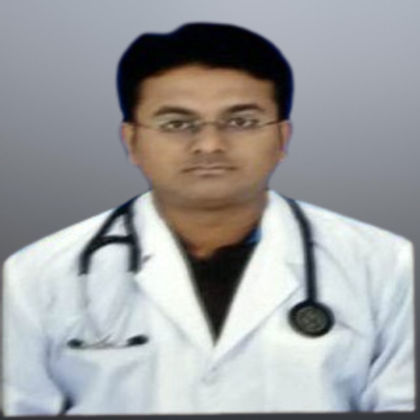What Is Pulmonary Embolism?
Learn about pulmonary embolism, a serious condition caused by blood clots in the lungs. Discover its causes, symptoms, diagnosis, treatment, and prevention strategies.

Written by Dr.Sonia Bhatt
Last updated on 3rd Jul, 2025
Introduction
A pulmonary embolism occurs when a blood clot blocks an artery in the lungs, restricting blood flow. In most cases, the clot originates in a deep vein in the leg and travels to the lungs, a condition known as deep vein thrombosis (DVT). Less commonly, clots may form in veins elsewhere in the body.
Pulmonary embolism can be life-threatening due to the disruption of blood flow to the lungs. However, prompt treatment significantly reduces the risk of serious complications. Taking preventative steps to reduce blood clot formation, particularly in the legs, is key to lowering the risk. In this article, we will explore pulmonary embolism in detail.
Causes of Pulmonary Embolism
A pulmonary embolism occurs when a blockage, usually a blood clot, obstructs an artery in the lungs, restricting blood flow. These clots most commonly originate from the deep veins in the legs, a condition known as deep vein thrombosis (DVT).
In many cases, multiple clots may be involved, leading to reduced blood supply to affected areas of the lungs. This can result in pulmonary infarction, where lung tissue dies due to a lack of oxygen, making it harder for the lungs to supply oxygen to the rest of the body.
While blood clots are the most common cause of pulmonary embolism, other substances can also lead to blockages, including:
Fat released from the marrow of a broken long bone
Fragments of a tumour
Air bubbles entering the bloodstream
Risk Factors of Pulmonary Embolism
While anyone can develop blood clots leading to a pulmonary embolism, certain factors increase the risk:
1. History of Blood Clots
A personal or family history of venous blood clots or pulmonary embolism increases the likelihood of recurrence.
2. Medical Conditions and Treatments
Heart Disease – Conditions such as heart failure can raise the risk of clot formation.
Cancer – Certain cancers, including those of the brain, ovary, pancreas, colon, stomach, lung, and kidney, as well as cancers that have spread, can increase clotting risk. Chemotherapy and medications like tamoxifen or raloxifene also contribute to the risk.
Surgery – Major surgeries, particularly joint replacements, increase the likelihood of clot formation, necessitating preventive medication.
Clotting Disorders – Inherited or medical conditions such as kidney disease can make the blood more prone to clotting.
COVID-19 – Severe cases of COVID-19 have been linked to a higher risk of pulmonary embolism.
3. Extended Periods of Inactivity
Bed Rest – Prolonged immobility due to surgery, illness, or injury slows blood flow, increasing the risk of clots forming in the legs.
Long Journeys – Sitting for extended periods during long-haul flights or car journeys can cause blood to pool in the legs, leading to clot formation.
4. Other Risk Factors
Smoking – Tobacco use raises the risk of clotting, particularly in individuals with other contributing factors.
Excess Weight – Being overweight increases the likelihood of blood clot formation, especially when combined with additional risk factors.
Hormonal Factors – Oestrogen from birth control pills or hormone replacement therapy can raise clotting risks, particularly in smokers or those who are overweight.
Pregnancy – The pressure exerted by the growing baby on veins in the pelvis can slow blood return from the legs, making clot formation more likely.
Pathophysiology
The pathophysiology of pulmonary embolism includes:
1. Obstruction of the Pulmonary Artery: A blood clot lodges in the pulmonary artery, partially or completely blocking one or more blood vessels.
2. Increased Pulmonary Vascular Resistance: The clot, along with hypoxic vasoconstriction, raises resistance to blood flow within the pulmonary circulation.
3. Alveolar Dead Space: Ventilation continues, but perfusion is significantly reduced or absent, leading to an increase in alveolar dead space.
4. Right Ventricular Failure: The right ventricle dilates due to increased strain, reducing its ability to pump blood effectively, which can result in hypotension.
Symptoms of Pulmonary Embolism
The symptoms of pulmonary embolism can vary depending on the extent of lung involvement, the size of the blood clots, and any underlying heart or lung conditions.
Common Symptoms includes:
Shortness of breath – Often sudden in onset, causing difficulty in breathing even at rest and worsening with physical activity.
Chest pain – Sharp pain, similar to a heart attack, which worsens when taking a deep breath, coughing, bending, or leaning forward.
Fainting (Syncope) – A sudden drop in heart rate or blood pressure may lead to loss of consciousness.
Other Possible Symptoms are as follows:
Persistent cough, sometimes producing blood-streaked mucus
Rapid or irregular heartbeat (palpitations)
Dizziness or lightheadedness
Excessive sweating
Fever
Leg pain or swelling, usually at the back of the lower leg
Clammy or discoloured skin (cyanosis)
Diagnosis
The diagnosis of pulmonary embolism includes the following:
1. Medical History and Physical Examination
Diagnosing a pulmonary embolism can be challenging, particularly in individuals with pre-existing heart or lung conditions. Healthcare professionals will review your medical history, assess symptoms, and conduct a physical examination to determine the likelihood of a blood clot.
2. Diagnostic Tests and Imaging Techniques
Diagnostic tests and imaging techniques includes:
Blood Tests – Measure D-dimer levels to detect clotting activity, oxygen and carbon dioxide levels, and potential inherited clotting disorders.
Chest X-ray – Helps rule out other conditions with similar symptoms but cannot directly diagnose a pulmonary embolism.
Ultrasound – Uses sound waves to check for deep vein thrombosis (DVT) in the legs or arms.
CT Pulmonary Angiography – A specialised CT scan that provides detailed 3D images of the pulmonary arteries, often using contrast dye.
Ventilation-Perfusion (V/Q) Scan – A radioactive tracer maps blood flow and airflow in the lungs, useful for those unable to undergo a CT scan.
Pulmonary Angiogram – The most accurate test, involving the insertion of a catheter and contrast dye to visualise blood flow in the lung arteries, though it carries some risks.
MRI – Typically used for pregnant individuals or those with kidney issues to avoid radiation or contrast dye exposure.
Treatment Options
The treatment option for pulmonary embolism includes:
1. Medications
The medications required for pulmonary embolism are as follows:
Blood Thinners (Anticoagulants): Prevent existing clots from growing and new clots from forming. Heparin is often used initially, followed by oral anticoagulants like warfarin or newer direct-acting anticoagulants.
Clot Dissolvers (Thrombolytics): Used in severe cases to rapidly break down clots but carry a high risk of bleeding.
2. Surgical and Procedural Interventions
The surgical and procedural intervention includes:
Clot Removal: A catheter may be used to extract a large, life-threatening clot.
Vein Filter: A filter placed in the inferior vena cava prevents clots from reaching the lungs, used when anticoagulants are unsuitable.
3. Ongoing Care
The ongoing care includes:
Long-term anticoagulation therapy may be necessary to reduce the risk of further clots.
Regular monitoring with healthcare professionals helps manage complications and adjust treatment as needed.
Complications
Pulmonary embolism can be life-threatening, with a high mortality rate if left untreated. However, prompt diagnosis and treatment significantly improve survival rates.
Pulmonary Hypertension: Blocked arteries in the lungs force the heart to work harder, raising blood pressure and weakening the heart over time.
Chronic Pulmonary Hypertension: In rare cases, persistent small clots cause scarring in the pulmonary arteries, restricting blood flow and leading to long-term complications.
Prevention Strategies
The preventive strategies for pulmonary embolism includes:
1. Hospital Measures
The hospital measures are as follows:
Blood Thinners: Anticoagulants are given before and after surgery or for medical conditions like heart attack or stroke.
Compression Stockings: Help improve blood flow and prevent pooling in the legs.
Leg Elevation: Raising legs by 10–15 cm aids circulation.
Physical Activity: Early movement post-surgery reduces clot risk.
Pneumatic Compression: Inflating cuffs massage the legs to boost blood flow.
2. Prevention While Travelling
The travelling measures includes:
Stay Hydrated: Drink water and avoid alcohol.
Move Regularly: Walk every hour on flights or take breaks when driving.
Leg Exercises: Rotate ankles and flex toes every 15–30 minutes.
Wear Support Stockings: Improve circulation and reduce swelling.
Conclusion
Pulmonary embolism is a serious, potentially life-threatening condition, but timely diagnosis and treatment can significantly improve outcomes. Prevention is key, especially for those at risk, through lifestyle measures, early mobilisation, and medical interventions. Staying proactive with regular check-ups and following medical advice can help reduce the risk and ensure better long-term health.
Consult Top Respiratory Disease Specialist
Consult Top Respiratory Disease Specialist

Dr Rikin Hasnani
Pulmonology Respiratory Medicine Specialist
14 Years • MBBS NTR University of Health Sciences MD NTR University of Health Sciences
Hyderguda
Apollo Hospitals Hyderguda, Hyderguda

Dr. Keshavan. V.
Pulmonology Respiratory Medicine Specialist
10 Years • "MBBS (CMC, Vellore) MD (CMC, Vellore) DNB EDARM (France) SCE(UK) ATSF (USA) MRCPS (Glasgow) FCCP (USA) FAPSR (Japan) MNAMS"
Hyderguda
Apollo Hospitals Hyderguda, Hyderguda

Dr. Sumara Maqbool
Pulmonology Respiratory Medicine Specialist
12 Years • MBBS, DNB Respiratory, critical care and sleep medicine, DrNB superspeciality Critical care, IDCCM, IFCCM, EDIC
Delhi
Apollo Hospitals Indraprastha, Delhi
(25+ Patients)

Dr. Ravi Charan Avala
Pulmonology Respiratory Medicine Specialist
3 Years • DNB, DTCD
Chinagadila
Apollo Hospitals Health City Unit, Chinagadila
(25+ Patients)

Dr. Aakanksha Chawla
Pulmonology Respiratory Medicine Specialist
9 Years • MD (Pulmonary Medicine), IDCCM, IFCCM (Indian Fellowship in Critical Care Medicine)
Delhi
Apollo Hospitals Indraprastha, Delhi
(250+ Patients)
